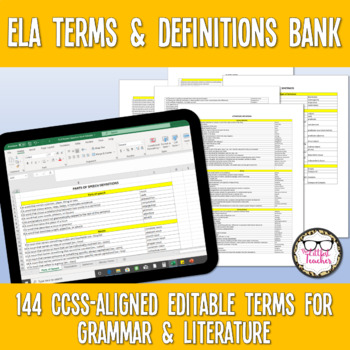ELA Editable Grammar & Literature Terms Bank CCSS Aligned
- Zip
- Excel Spreadsheets
Description
This glossary of grammar and literature terms and their definitions will help any English teacher be more organized, and save time when creating activities and assessments.
You can add, remove, or edit terms and definitions to meet your needs, then quickly copy and paste into other applications like slideshows, worksheets, documents, etc.
You can distribute copies to students for reference and study.
You'll receive:
- A bank of 144 CCSS-aligned grammar and literature terms and definitions in an editable Excel spreadsheet, numbered, and organized into sections and sheets
- The same collection of terms and definitions in a ready-to-print PDF file
Grammar terms included:
noun • verb • preposition • conjunction • interjection • pronoun • adjective • adverb • concrete noun • abstract noun • count noun • non-count noun • proper noun • common noun • collective noun • compound noun • action verb • state of being verb • helping (or auxiliary) verb • linking verb • transitive verb • intransitive verb • active voice • passive voice • verbal • gerund • participle • infinitive • object of the preposition • compound preposition • subjunctive • coordinating • correlative • antecedent • nominative (or subjective) • objective • personal • indefinite • demonstrative • possessive • intensive • proper adjective • possessive • period • comma • exclamation point • question mark • semicolon • colon • hyphen • dash • quotation marks • apostrophe • parentheses • brackets • declarative • interrogative • imperative • exclamatory • subject • verb • predicate • complement • predicate noun (nominative) • predicate adjective • direct object • indirect object • phrase • dependent clause • independent clause • simple • compound • complex • compound-complex
Literature terms included:
theme • main idea • moral • tone • mood • plot • conflict • setting • characters • protagonist • antagonist • point of view • dialogue • narrator • first-person POV • second-person POV • third-person POV • third-person limited • third-person omniscient • objective POV • dynamic character • static character • flat character • drama • fable • poetry • biography • autobiography • fairytale • mythology • science fiction • historical fiction • tall tale • folk tale or folk lore • legend • essay • screenplay • novel • memoir • narrative nonfiction • epic • allegory • alliteration • allusion • analogy • anecdote • anthropomorphism • aphorism • archetype • assonance • cacophony • caesura • connotation • denotation • euphemism • euphony • flashback • foil • foreshadowing • hyperbole • imagery • verbal irony • dramatic irony • situational irony • juxtaposition • metaphor • monologue • motif • onomatopoeia • oxymoron • paradox • parallelism • personification • pun • satire • simile • stream of consciousness • symbol • synecdoche understatement
*Please note: Not every single term and definition will be applicable to every single grade- please plan on using the portion of the material that fits your curriculum. If you teach multiple grades, this resource will be a huge time-saver for you!
This terms & definitions bank is already included in my ELA Games Pack!
Reinforce key terms and definitions visually with these colorful posters!
After you purchase, don't forget to leave feedback to earn TPT credits that you can put toward future purchases!



